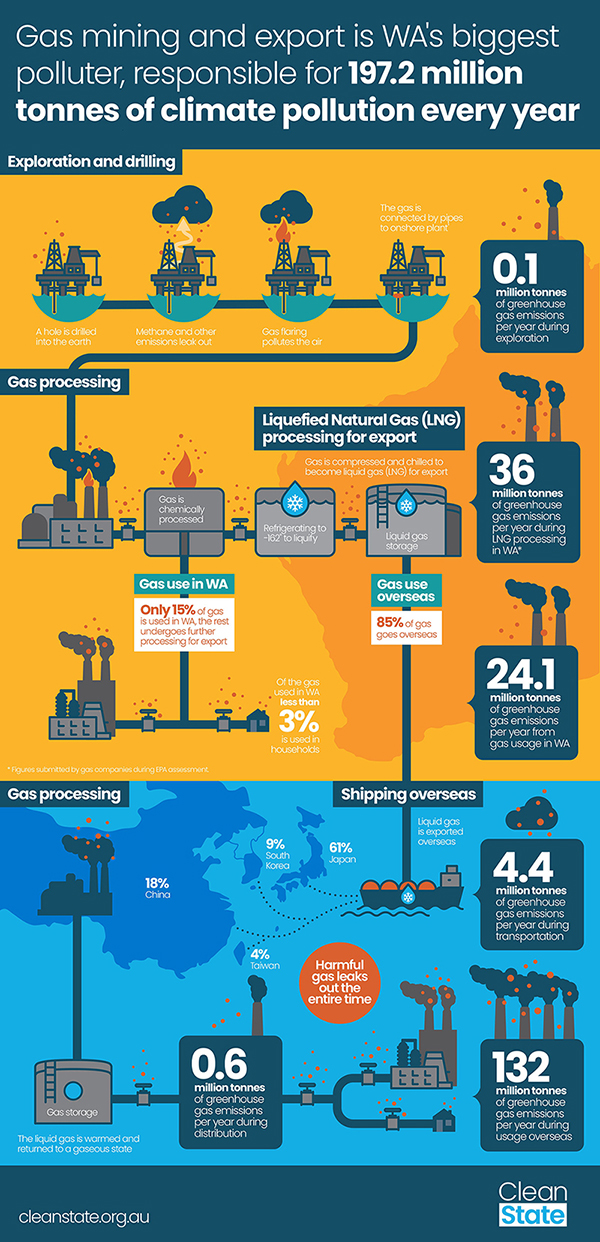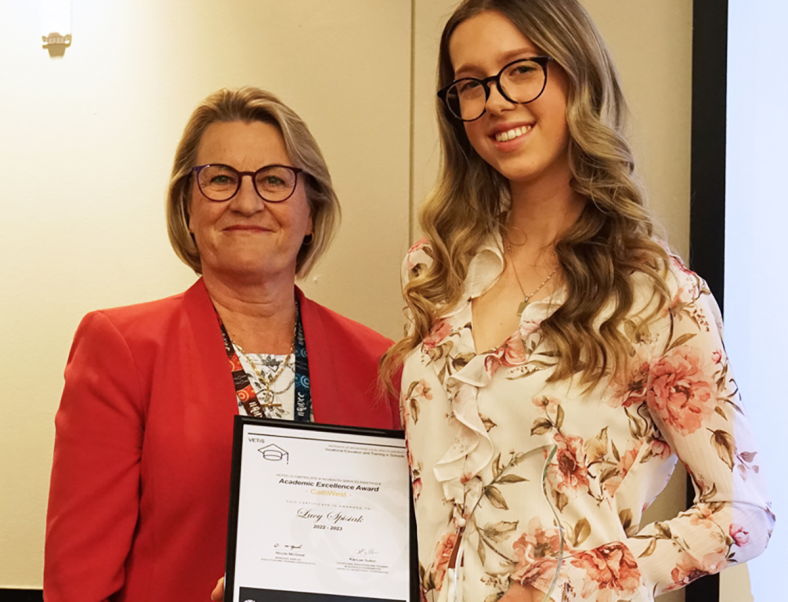It’s time to scrutinise the increasing pollution coming from WA’s burgeoning gas industry, and do something about it.
By Chris Johansen
Western Australia’s greenhouse gas (GHG) emissions are rising faster than in any other state, primarily due to the expansion of liquified natural gas (LNG) exports. WA has now surpassed Qatar as the jurisdiction with the largest export of LNG, granting the state the dubious title of ‘world champions’.
The extent of pollution from the WA LNG industry is depicted in the infographic below. Please note that of the total annual GHG emissions (197.2 million tonnes), only about one-third is accounted as WA emissions in the national GHG inventory. The other two-thirds result from GHG emissions from use of the LNG in export destinations.

Even more amazing is that the multinational companies extracting, processing and exporting this natural gas avoid paying royalties and taxes, as these are based on ‘profits’ that those skilled in creative accounting can game. Essentially, we are giving away our resources for free to the world’s largest multinationals, with the exploitation of those resources significantly contributing to the climate crisis, while the government relies on taxes collected from ordinary people. Quite gobsmacking!
Particularly in view of the expanding LNG export industry, the WA Environmental Protection Authority (EPA) had been preparing guidelines specifically for addressing GHG pollution in WA. It released those guidelines in March of this year but after intense pressure from the oil and gas industry, and criticism from the federal government, Labor premier Mark McGowan said he would not endorse the guidelines. The EPA immediately withdrew the guidelines but reopened an extended consultation period, to 2September.
A major argument of the opposing multinationals, and of the Commonwealth Minister for Energy and Emissions Reduction, Angus Taylor, was that increasing export of LNG decreases global GHG emissions as LNG replaces coal, which is more emissions intensive. Err, no: according to the Global Energy Monitor, full life cycle emissions from current LNG export proposals exceed those from proposed new coal plants. Fugitive emissions and leakages in LNG extraction, processing and transport boost its full life cycle emissions to levels comparative with coal. If the Minister was really concerned about global GHG emissions, he would suggest that overseas coal burning convert to low emissions renewable energy, which in any case is now cheaper than importing LNG.
Another major concern of the LNG multinationals was the prospect of having to pay for GHG emission offsets for GHG emissions of an enterprise exceeding 100,000 tonnes of CO2 per annum. Indeed, a technical requirement for establishment of the Gorgon Project was that they establish a carbon capture and storage facility, to pump CO2 underground, but they have reneged on that. Offsets involve carbon capture in geological reservoirs or vegetation (e.g. reafforestation). Such extra costs would certainly tarnish the golden egg upon which they now sit.
The GHG guidelines would not only apply to existing and proposed gas extraction sites on the North-west Shelf but also to existing petroleum exploration areas on land, and mainly in the Kimberley. The state government lifted the fracking ban on these areas last November.
Clean solutions
In reaction to this blatant display of corporate muscle, Clean State, a campaign under the auspices of the Conservation Council of WA (CCWA), organised a ‘WA Climate Pollution Forum’ in June. Clean State aims to highlight the GHG pollution caused by LNG production in WA and propose solutions to it. Kate Kelly convened the forum, which featured several prominent speakers: WA Chief Scientist Prof. Peter Klinken; Dr Hugh Finn of Curtin University Law School; EPA Deputy Chair Robert Harvey; Tim Macknay, a solicitor with the Environment Defenders Office (EDO); and Kent Broad, representing ‘Outback Carbon’.
Presentations and subsequent Q&A highlighted that WA is now considered a global example of climate change underway – there has been a marked decrease in rainfall in southern WA over the previous half century, as the winter rain-bearing cold fronts track further south. In view of this ever-worsening consequence, logic would suggest that WA would be particularly concerned about further exacerbating climate change through increased GHG emissions.
However, on the contrary, it seems: WA’s GHG emissions were up some 23 percent from 2005 levels, with prospects of increasing rates of emissions as more offshore gas wells come online and the state moratorium on fracking is lifted. In that period, emissions in the other states were trending downwards as renewable energy is being increasingly deployed and some coal-fired power stations closed down. Further, all states and territories, except WA and the Northern Territory, have legislation or policy targeting zero net emissions by 2050.
During the course of this forum, it was clarified that the basic role of the WA EPA is to use its best endeavours to protect the environment and prevent, control and abate pollution and environmental harm. However, it is merely an advisory body to the state government and has no direct regulatory powers. It sets the parameters for legislation for the state government to implement and be responsible for enforcing. The EPA approaches GHG mitigation as three-fold: avoiding them in the first place (e.g. low emissions energy, energy efficiency); reducing them over time (e.g. reduce leaks, phase in energy efficient equipment); and offsetting them (e.g. revegetation).
Rather than general comments about climate change and GHG emissions, the EPA sought more technical inputs supported by validated data if possible. Specifically, they requested inputs on:
- greenhouse gas emissions and their mitigation in WA;
- how the proposed guidelines would contribute and commit to meeting Australia’s emissions reduction targets;
- the need for, and any reasonable constraints on, transparency in emissions data and proposed mitigations;
- the scope of emissions to be considered, including the relevance and context for considering indirect (Scope 3) emissions;
- the relationship to national or state emissions targets and regulation;
- consistency with the EPA’s duty to use its best endeavours to protect the environment;
- the appropriateness and practicability of measures to mitigate greenhouse gas emissions, including nature and level of planned reductions or offsets;
- the timing of planned reductions or offsets; and
- the kinds or size of proposals to which the guidelines should apply.
In a personal submission, I identified the following as areas of focus:
- The arguments that WA’s LNG emissions do indeed significantly contribute to global GHG emissions, well into the future, rather than lowering them.
- Accurate quantification of emissions, particularly fugitive emissions. Emissions of methane from usage of natural gas, from extraction to end use, are likely underestimated. Emitters in Australia are currently only required to self-report their emissions, creating further propensity for underestimation of emissions. There needs to be independent and more comprehensive assessment of fugitive emissions. Use of drones fitted with appropriate gas sampling instrumentation could facilitate this.
- The use of offsets, which to me is problematic. An offset option provides legitimacy for emitting industries to continue emitting, rather than concentrating on how to reduce those emissions. Carbon capture and storage facilities are costly and yet to be shown as effective. Promises by fossil industries to install them have not been fulfilled, nor apparently have they been insisted upon by regulatory authorities. Use of revegetation as a means of offset poses several hazards – dodgy accounting, fire and other threats to plantings. Revegetation should proceed as a priority irrespective of any reliance on funding from fossil fuel industries as offset payments.
- Phasing out of natural gas use, and replacing it, particular in WA’s north, with a solar powered hydrogen economy. Planning for this in the Pilbara is already underway.
Chris Johansen is the co-editor of the Green Issue and a long-time Greens WA member.
A version of this article was originally published in Green Issue. The views and opinions expressed in this article are those of the author and do not necessarily reflect the official policy or position of the Greens.








